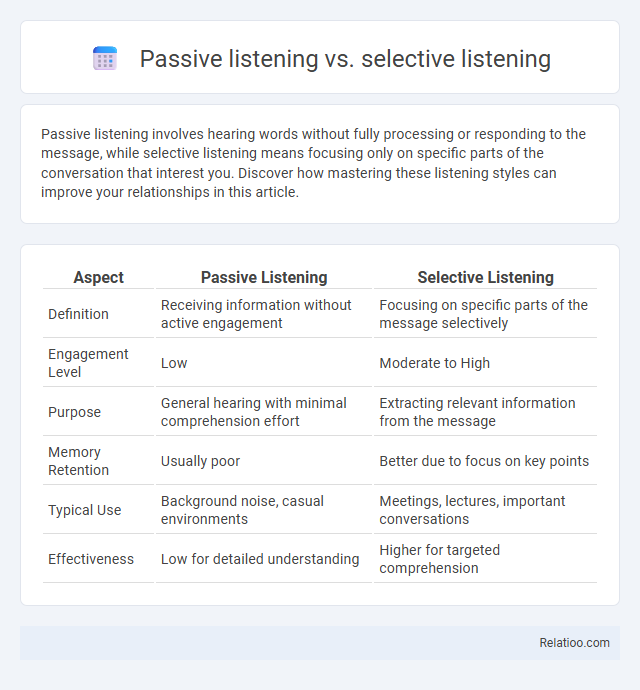Passive listening involves hearing words without fully processing or responding to the message, while selective listening means focusing only on specific parts of the conversation that interest you. Discover how mastering these listening styles can improve your relationships in this article.
Table of Comparison
| Aspect | Passive Listening | Selective Listening |
|---|---|---|
| Definition | Receiving information without active engagement | Focusing on specific parts of the message selectively |
| Engagement Level | Low | Moderate to High |
| Purpose | General hearing with minimal comprehension effort | Extracting relevant information from the message |
| Memory Retention | Usually poor | Better due to focus on key points |
| Typical Use | Background noise, casual environments | Meetings, lectures, important conversations |
| Effectiveness | Low for detailed understanding | Higher for targeted comprehension |
Understanding Passive Listening
Passive listening involves hearing sounds without actively processing or responding, resulting in minimal retention and understanding. Selective listening requires focusing on specific information while ignoring other stimuli, enhancing comprehension of the chosen content. Your ability to engage in active listening, rather than passive listening, directly impacts how effectively you absorb and interpret information in conversations or presentations.
Defining Selective Listening
Selective listening involves actively focusing on specific sounds or information while ignoring others, enhancing comprehension and retention. Unlike passive listening, which requires minimal mental engagement, selective listening demands concentration to filter messages based on relevance or importance. Understanding selective listening helps you improve communication skills by tuning into critical details amid background noise.
Key Differences Between Passive and Selective Listening
Passive listening involves hearing sounds without responding or engaging, whereas selective listening requires actively choosing specific sounds or information to focus on amid distractions. The key difference lies in engagement; passive listening demands minimal cognitive effort, while selective listening requires your conscious attention to filter important details from background noise. This distinction impacts how effectively you absorb and process auditory information in different environments.
Psychological Impacts of Listening Styles
Passive listening often leads to reduced cognitive engagement, causing your brain to process information superficially and potentially fostering misunderstandings or apathy. Selective listening, which involves focusing on specific parts of a conversation, can create psychological barriers like bias and distorted perception, limiting empathy and effective communication. Active listening, contrastingly, enhances psychological well-being by promoting deeper connection, validating emotions, and encouraging mental clarity and retention.
Passive Listening in Everyday Communication
Passive listening involves hearing sounds without actively processing or responding to the information, often leading to missed details in conversations. Selective listening requires focusing on specific parts of the message, prioritizing certain information based on relevance or interest. Your communication effectiveness improves significantly when you recognize the differences, especially by minimizing passive listening to enhance understanding and engagement in everyday interactions.
The Role of Selective Listening in Relationships
Selective listening plays a crucial role in relationships by enabling you to focus on important messages while filtering out distractions, fostering better understanding and emotional connection. Unlike passive listening, which often results in missed details, selective listening requires active mental engagement to prioritize key information that impacts communication dynamics. Your ability to selectively listen can enhance empathy, reduce misunderstandings, and build stronger interpersonal bonds.
Benefits and Drawbacks of Passive Listening
Passive listening involves hearing sounds without actively engaging or processing the information, which can benefit You by reducing cognitive load and allowing for background awareness. However, the drawback is that important details or nuances may be missed, leading to misunderstandings or ineffective communication. Unlike selective or active listening, passive listening does not require focused attention, making it less effective for learning or problem-solving but useful in low-demand auditory environments.
Advantages and Risks of Selective Listening
Selective listening enhances your ability to focus on relevant information, improving comprehension and decision-making in noisy environments or multitasking situations. It helps filter out distractions, increasing efficiency and communication effectiveness. Risks include missing important details outside of your focus area and potential misunderstandings if key information is overlooked.
How to Shift from Passive to Selective Listening
Shifting from passive to selective listening requires conscious effort to focus on critical information while filtering out distractions. Active engagement techniques such as note-taking, asking clarifying questions, and summarizing key points enhance attention and comprehension during conversations or presentations. Training auditory processing skills through mindfulness practices and structured listening exercises can significantly improve selective listening abilities.
Enhancing Communication Skills Through Effective Listening
Passive listening involves hearing words without actively engaging or processing the information, which limits comprehension and communication effectiveness. Selective listening filters specific parts of the message, potentially missing important details but allowing focus on key points relevant to personal interests. Developing active listening skills by combining attention, feedback, and understanding enhances communication by ensuring messages are fully received, interpreted, and responded to appropriately.

Infographic: Passive listening vs Selective listening
 relatioo.com
relatioo.com